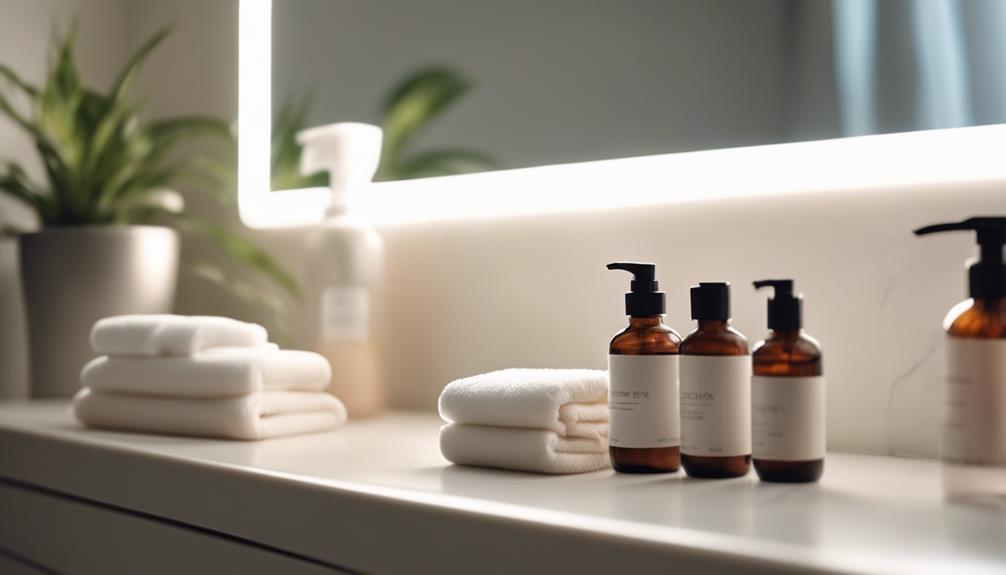A simple skincare routine is all about knowing your skin type. Make sure to cleanse your face twice a day using a gentle cleanser to get rid of impurities. After that, moisturize with a product that hydrates your skin without blocking pores. And don’t forget sunscreen! Apply it every day with an SPF of 30 or higher to shield your skin from UV damage. You might want to think about adding exfoliation to your routine once or twice a week to improve your skin’s texture. Remember, consistency is crucial for seeing real results, which usually takes a couple of months. If you’re interested in more tips and tricks to improve your routine, there’s a lot more to discover!
Key Takeaways
- Start with cleansing twice daily using gentle, hydrating cleansers suitable for your skin type to maintain a clear complexion.
- Follow up with a moisturizer tailored to your skin type, ensuring hydration without clogging pores.
- Apply sunscreen daily with at least SPF 30, even on cloudy days, to protect against UV damage.
- Incorporate exfoliation 1-2 times a week, using either physical or chemical exfoliants to improve skin texture and clarity.
Importance of Skincare
Skincare isn't just about looking good; it's essential for your overall health and well-being. The importance of skincare lies in its ability to protect your skin from damage, keep it hydrated, and maintain its natural barrier. By establishing a basic skin-care routine, you can address specific skin concerns like dryness, acne, or sensitivity.
Start with fundamental skin-care routine steps: cleansing, moisturizing, and sun protection. Cleansing removes impurities, while moisturizing keeps your skin hydrated and supple. Don't overlook sun protection, as harmful UV rays can lead to premature aging and skin cancer.
Different skin types, whether oily, dry, combination, sensitive, or normal, require tailored approaches to achieve the best results. Understanding your skin type helps you choose the right products and techniques.
Most importantly, consistency in a skincare routine is vital. It often takes 2-3 months of regular use to notice significant improvements. So, stick with it! By prioritizing your skincare, you're investing in not just your appearance but your overall health and confidence. Commit to these simple steps, and your skin will thank you in the long run.
Understanding Your Skin Type
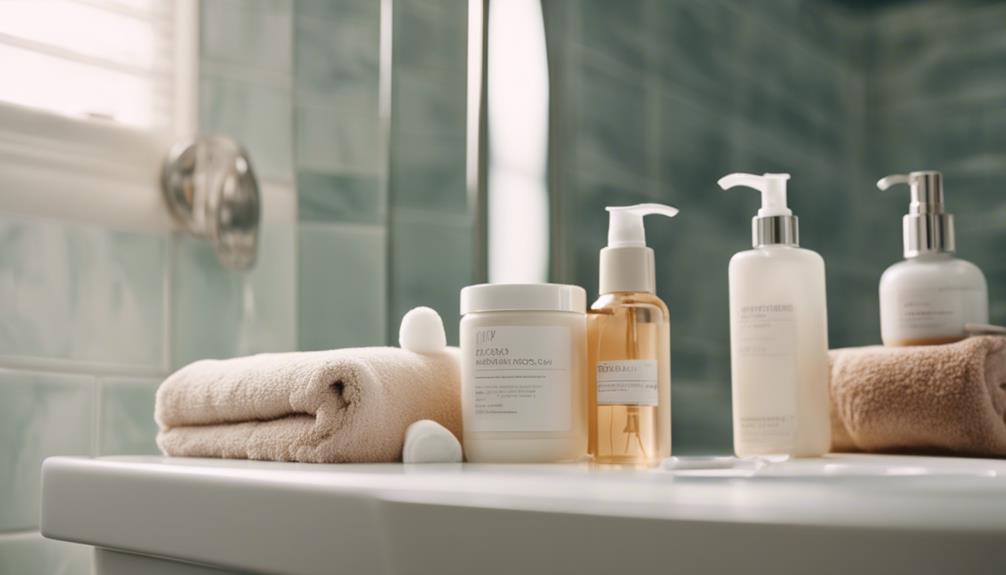
Knowing your skin type is essential for choosing the right products and creating an effective routine tailored to your unique needs. There are five main skin types: oily, dry, combination, sensitive, and normal.
Oily skin tends to produce excess sebum, resulting in larger pores and a higher likelihood of acne. If this sounds familiar, you'll want to pick non-comedogenic cleansers and mattifying moisturizers.
Dry skin often feels tight and may appear flaky. For this type, look for rich, hydrating moisturizers packed with ingredients like hyaluronic acid to help retain moisture.
If you have sensitive skin, you know it can react negatively to harsh ingredients. Gentle, fragrance-free products are crucial for maintaining its health without causing irritation.
Combination skin features both oily and dry areas, so you'll need a balanced routine that addresses the unique needs of each zone.
Essential Daily Steps
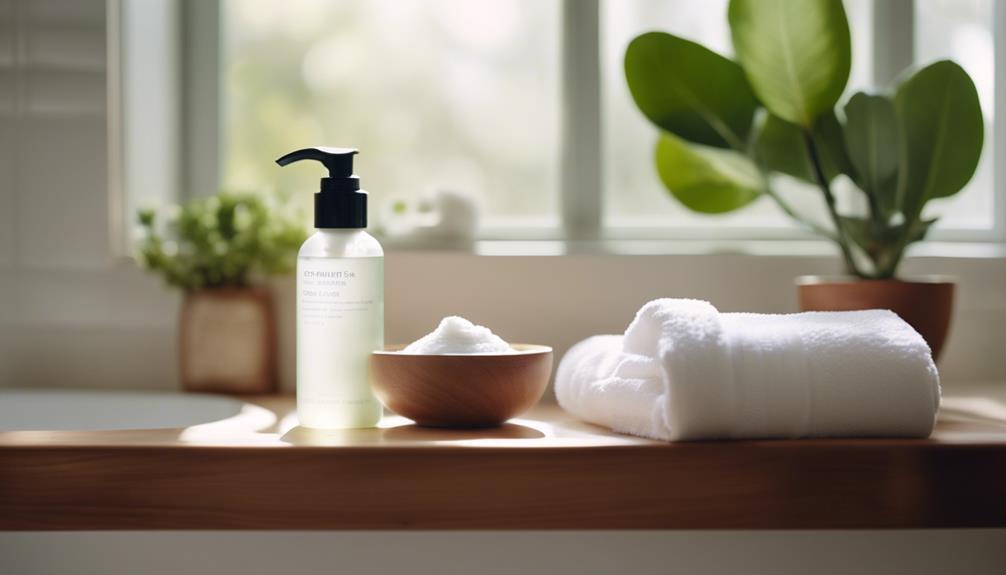
To achieve healthy skin, follow these essential daily steps: cleansing, moisturizing, and applying sunscreen.
Start your day with cleansing, using gentle cleansers like CeraVe Hydrating Facial Cleanser or Cetaphil Gentle Skin Cleanser. These products effectively remove impurities without stripping your skin of moisture. Aim to cleanse your face twice daily—once in the morning and once before bed—to maintain ideal skin health.
After cleansing, it's time for moisturizing. Choose a suitable moisturizer, such as La Roche-Posay Toleriane or Clinique Dramatically Different Gel. These moisturizers hydrate your skin and lock in moisture, utilizing beneficial ingredients like hyaluronic acid and ceramides to support your skin's barrier.
Lastly, don't skip sunscreen! Daily application of sunscreen with an SPF of 30 or higher is vital, even on cloudy days. Protecting your skin from UV damage helps prevent skin cancer and premature aging. Recommended options include EltaMD UV Active and Supergoop Glowscreen.
Cleansing Techniques
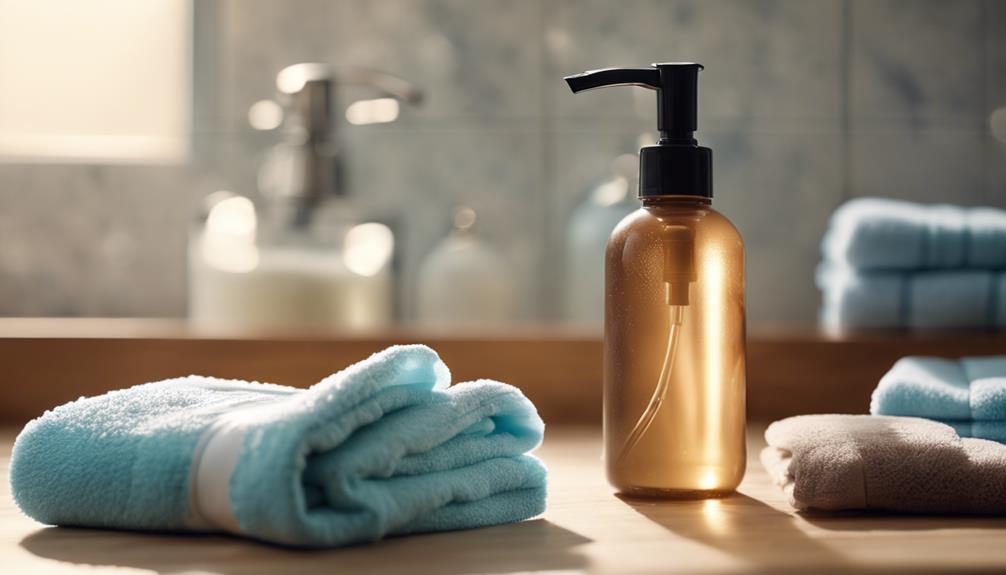
Cleansing is an essential step in your skincare routine, and using the right techniques can make all the difference.
You should choose a gentle cleanser suited to your skin type and apply it properly to maximize its benefits.
Let's explore the importance of cleansing, recommend some effective products, and discuss the best techniques to guarantee your skin stays fresh and healthy.
Importance of Cleansing
Regularly cleansing your skin is essential for removing dirt, oil, and impurities that can lead to clogged pores and breakouts. By incorporating cleansing into your daily routine, you can maintain a healthy skin barrier and achieve a clear complexion.
Here are three important steps to follow:
- Choose a Gentle Cleanser: Select a gentle cleanser that suits your skin type. Avoid harsh formulas that can strip your skin of essential moisture.
- Use Lukewarm Water: When cleansing, use lukewarm water to help open your pores. This allows the cleanser to penetrate more effectively, removing excess oil and impurities.
- Cleanse Twice Daily: Aim to cleanse your face twice a day—once in the morning and once before bed. This regular cleansing routine prepares your skin for better absorption of skin-care products, promoting a radiant look over time.
Cleansing Products Recommendations
Start your cleansing routine with effective products that cater to your skin type and address specific concerns. For a gentle yet effective cleanse, consider using a hydrating cleanser like CeraVe Hydrating Facial Cleanser or Cetaphil Gentle Skin Cleanser. These cleansing products are suitable for all skin types and help maintain your skin's moisture balance while guaranteeing thorough cleansing.
It's essential to cleanse your face twice daily. In the morning, you'll remove sweat and oil, while at night you'll eliminate makeup and daily impurities. Use lukewarm water to open your pores and apply the cleanser in a circular motion for at least one minute. This method helps achieve a deeper clean and targets any stubborn dirt.
If you wear heavy makeup or sunscreen, double cleansing is a great option. Start with an oil-based cleanser to break down makeup, followed by your gentle skin cleanser to remove any remaining residue. Always rinse thoroughly to guarantee no cleanser residue is left behind, as leftover product can lead to clogged pores and irritation.
Proper Cleansing Techniques
To achieve the best results from your skincare routine, mastering proper cleansing techniques is crucial. Start by using a mild cleanser that suits your skin type, as this helps effectively remove dirt and oil without stripping your skin's natural moisture.
Follow these steps for an ideal cleansing experience:
- Prep Your Skin: Rinse your face with lukewarm water to open up the pores. This action allows the cleanser to better remove impurities.
- Cleanse Gently: Apply the cleanser using gentle, circular motions for about one minute. Pay special attention to oil-prone areas like your nose and forehead.
- Thorough Rinse: Make sure to rinse your face thoroughly until no cleanser remains, as leftover product can lead to irritation and clogged pores.
If you wear heavy makeup or sunscreen, consider double cleansing. Start with an oil-based cleanser to break down the product, followed by your mild cleanser for a deep clean.
Choosing the Right Products

Choosing the right skincare products hinges on understanding your specific skin type, as this knowledge guides you toward the best formulations and ingredients for your needs. Whether you have oily, dry, combination, or sensitive skin, each type requires tailored care.
For oily or acne-prone skin, look for non-comedogenic products, as these help prevent clogged pores and breakouts. If your skin is sensitive, prioritize fragrance-free products with minimal ingredients to reduce the risk of irritation and allergic reactions.
Active ingredients play an essential role based on your skin concerns. For hydration, seek hyaluronic acid; for anti-aging, opt for retinol; and if acne is your main issue, choose salicylic acid. Knowing these active ingredients can help you target your skincare goals effectively.
Whenever you try a new product, always perform a patch test on a small area of skin first. This step is fundamental to guarantee compatibility and avoid any adverse reactions.
Incorporating Exfoliation
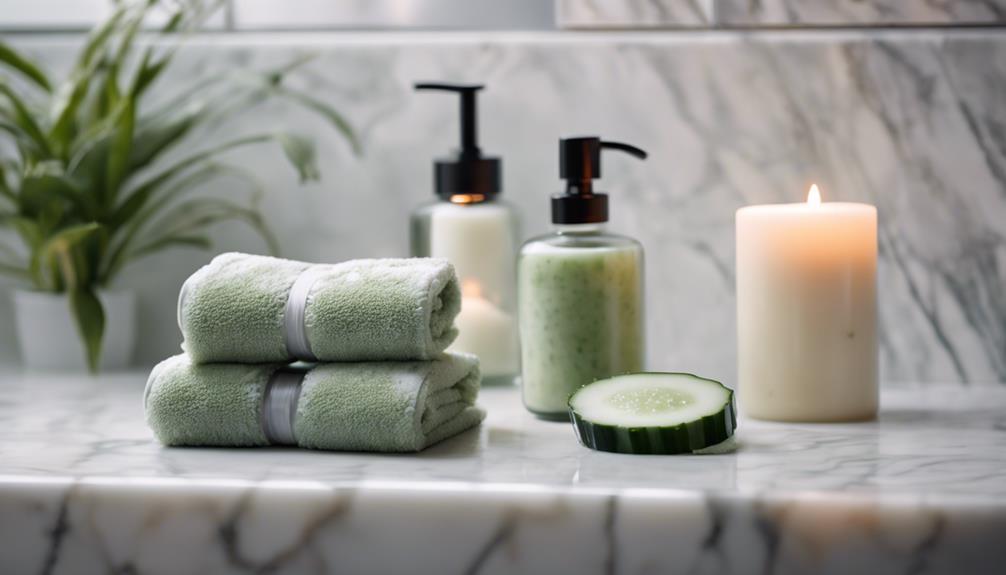
Now that you've chosen the right products, it's time to think about exfoliation.
You should aim to exfoliate once or twice a week, using either physical or chemical methods based on your skin type.
Timing is key, so always apply your exfoliant on clean, dry skin for the best results.
Exfoliation Techniques Overview
Exfoliation is an essential step in your skincare routine that helps remove dead skin cells and improve your skin's overall texture. Understanding the different exfoliation techniques can help you choose the best method for your skin type.
Here are the main types of exfoliation techniques:
- Physical Exfoliants: These include manual scrubs that physically slough off dead skin cells. While effective, be cautious, as they can be abrasive and cause irritation if used too frequently.
- Chemical Exfoliants: These involve the use of AHAs and BHAs to dissolve dead skin cells. For example, glycolic acid (an AHA) brightens dull skin, while salicylic acid (a BHA) penetrates deeper to address acne.
- Combination Exfoliants: Some products blend both physical and chemical exfoliants, offering a thorough approach to improving skin texture.
After exfoliating, always follow up with a hydrating moisturizer to replenish your skin. This step is vital, as exfoliated skin can be more susceptible to irritation and sun damage.
Remember to monitor your skin's reaction to avoid over-exfoliation, which can lead to redness and sensitivity.
Frequency and Timing
Finding the right frequency and timing for exfoliation can make a significant difference in your skincare results. Aim to exfoliate once or twice a week, depending on your skin type. For sensitive skin, stick to once a week to avoid irritation.
Incorporate exfoliation into your routine right after cleansing to effectively remove dead skin cells and boost the absorption of your other products.
When choosing your exfoliant, consider your skin concerns. Physical exfoliants like scrubs can be effective, but if you're dealing with dullness, chemical exfoliants like AHAs and BHAs might be gentler and more beneficial.
It's best to schedule exfoliation in the evening. This timing helps minimize sun sensitivity and allows your skin to recover overnight.
After exfoliating, always follow up with a hydrating serum and a moisturizer. This step is essential for maintaining skin hydration and supporting your skin barrier.
Active Ingredients to Consider

Taking into account the diverse benefits they offer, incorporating active ingredients like Vitamin C, Hyaluronic Acid, and Retinol into your skincare routine can greatly enhance your skin's health and appearance. These powerful components work effectively to address various skin concerns, ensuring you achieve that radiant glow.
Here are three key active ingredients to take into account:
- Vitamin C: This antioxidant brightens your skin, reduces signs of aging, and supports collagen production. It's ideal for morning use, giving your skin a fresh start to the day.
- Hyaluronic Acid: Known for its incredible ability to hold up to 1000 times its weight in water, it hydrates and plumps the skin, maintaining moisture levels throughout the day.
- Retinol: A potent derivative of Vitamin A, retinol promotes cell turnover, which helps reduce fine lines, wrinkles, and improves overall skin tone over time.
You might also want to explore Niacinamide for oil regulation and improved texture, and Salicylic Acid for acne treatment and gentle exfoliation.
Maintaining Consistency

Maintaining consistency in your skincare routine is crucial for achieving the best results from your products. Experts recommend using effective cleansers and other products daily, both morning and night. It typically takes 2-3 months for your skin to adjust to new products, so sticking to your routine is essential for evaluating their effectiveness.
Establishing a consistent regimen not only reinforces skin health but also improves your overall appearance. Even on busy days, make it a priority to follow through with your routine. This dedication will pay off in the long run.
Regularly reassessing your skin's needs and adjusting your products can enhance their effectiveness. As your skin changes, so should your routine; don't be afraid to adapt.
To further support your commitment to consistency, consider keeping a skincare journal. This tool can help you track product effectiveness and monitor changes in your skin over time.
Can I Start with a Simple Skincare Routine as a Beginner?
As a beginner, starting with easy skincare routine steps is a great way to ease into a consistent regimen. A simple routine of cleansing, moisturizing, and applying sunscreen can make a big difference in your skin’s health. Once you’re comfortable with these basics, you can gradually add more steps as needed.
Conclusion
By embracing a simple skincare routine, you're not just nurturing your skin—you're investing in yourself.
Remember, consistency is key, and each step is like a gentle hug for your complexion.
As you learn to understand your skin and choose the right products, you'll see how small changes can lead to glowing results.
So, take a deep breath, enjoy the process, and watch your confidence blossom as you reveal your healthiest, happiest skin yet.
